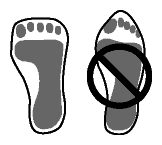Basic Ergonomics
You will be doing a lot of standing so it is important to cover some basic ergonomic tips. You should know that standing is a natural human posture and by itself poses no particular health hazard. This does not mean you do not have to be smart and aware of your working positions.
You have the opportunity to choose from a variety of well-balanced working positions and you should change between them frequently. Adjustability ensures that the worker has an opportunity to carry out work in well-balanced body positions.
What can I do to help myself?
You should simply move around from time to time changing your body position. While standing, use the foot rail area of the workstation to shift body weight from one leg to the other. Use your Lean-To seating when possible.
The benefits from greater flexibility and a variety of body positions are twofold. The number of muscles involved in the work is increased which equalizes the distribution of loads on different parts of the body. This lessens strain on the individual muscles and joints used to maintain the upright position. Changing body positions also improves blood supply to the working muscles. Both effects contribute to the reduction of overall fatigue.
Is there anything else I can do?
Quality of footwear and type of flooring materials are also major factors contributing to standing comfort.
Your feet can only be as comfortable as the footwear permits.
DO wear shoes that do not change the shape of your foot.
DO choose shoes that provide a firm grip for the heel. If the back of the shoe is too wide or too soft, the shoe will slip, causing instability and soreness.
DO wear shoes that allow freedom to move your toes. Pain and fatigue result if shoes are too narrow or too shallow.
DO ensure that shoes have arch supports. Lack of arch support causes flattening of the foot.
DO wear shoes with lace-up fastenings.
DO tighten the lace instep of your footwear firmly. The foot is prevented from slipping inside the footwear.
DO use padding under the tongue if you suffer from tenderness over the bones at the top of the foot.
DO use a shock-absorbing cushioned insole when working on metal or cement floors.
DO choose footwear according to the hazard at your workplace.
DO select safety footwear, if required, that is CSA approved and carries the proper ratings for the hazard. The OSH Answers document Safety Footwear has additional information.
DO select footwear taking into account individual fit and comfort. Try them on and walk around for a few moments before buying.
DO NOT wear flat shoes.
DO NOT wear shoes with heels higher than 5 cm (2 inches).
What if I am still having problems?
You are always encouraged to report discomforts or difficulties experienced during work.

